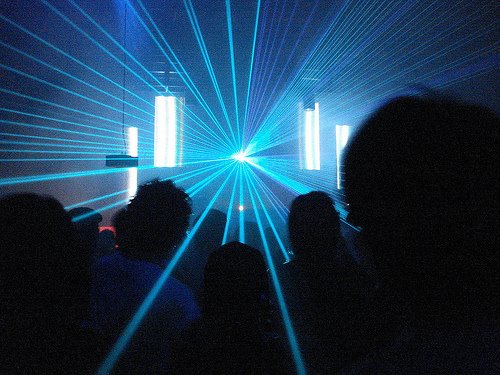And of course, as I was at this corner taking these pictures sirens started sounding all over the place and next thing I knew the building I was taking pictures of was surrounded by a firetruck, an ambulance and a police car. I decided that maybe I should just call it a night.
It was significantly busier than it was on Sunday... All around a poor night for doing this. I put together a few of the shots and they're littered with ghosts of cars and people. Not so good... (I'm also being lazy and doing my editing on my netbook instead of a real screen so it probably isn't fantastic looking).
 |
| From Random HDR |
I also took a few random shots as I was setting up. Had this one been taken from a lower angle I think it could've been really interesting... I still like it though... (I definitely prefer it to the HDR shots!)

5 comments:
What is an HDR image and why does it take so long to set up and take?
HDR = High Dynamic Range...
The process involves a few different exposures of the exact same image, letting in different amounts of light at each exposure. The end result is a set of pictures with a lot of detail in the high end (from the shorter exposures) and a lot of detail in the low end (from the longer exposures). Using photoshop or other fancy-dandy programs you can merge all the images into one...
I guess the important question is - why is an HDR photo desirable? It essentially allows you to show / control a wider range of luminance in a scene. [Here's a good example where detail is extremely strong in shadowey areas (behind barn) of the picture. Also the sun isn't blown out / overexposed.]
It actually doesn't take very long to take HDR shots if you know your camera. It's definitely faster for me to do it with my camera (a few seconds) than using a program like camera control. Camera Control does have a feature that does it automatically for some cameras (the process is called bracketing) - this doesn't work with my camera though.
... does that answer your questions?
So it's a sort of composite of several images? And I guess you merge the brightest parts of each image. I wonder if the cameras can do the merging on-board, or you could write software for it and then load it to the camera (if it can handle that)... And the number of images would probably vary on the scene, etc...
I guess the longer exposures make this tricky, resulting in the blurred images of moving cars, people, etc... so moving targets are probably out of the question?
And it's probably best done off a tripod or something stable too.
Cool idea...
It seems the result is an image that is closer to the way you actually see the scene.
The merging algorithm is fairly complex I think - not really something you'd want to do onboard a camera... Then again, I really don't know what I'm talking about here - that might actually be something interesting to read about... also - I'm not sure what you'd be gaining from doing it on your camera - it's not like you can really see anything on the tiny little LCD screen...
And yes, exactly - longer exposures do make HDR pictures trickier [especially when it's a busy intersection.] The number of exposures you have to take for an HDR image make it further complicated (at least 3 long exposure shots if it's at night). I had an idea about how to get around this yesterday... but... it's very time consuming and really, I want to be out taking pictures not sitting in front of my computer editing them. [This probably shows in the latest set of pictures which I'm not 100% sure of post-processing.]
It might be much faster if it's done in hardware, and connected to the sensors that are taking the picture. Of course it would probably be less configurable than Photoshop (but wouldn't exclude the possibility of editing with Photoshop afterwards). That being said, it might also suck the life right out of your batteries! I guess the advantage to doing in the camera would be that it's already done by the time you get back to your computer.
Hey! What if the camera had multiple sensors, each with their own aperature, and could send the image to each one at the same time for different exposures?
I got curious and took a look at Qtpfsgui (qtpfsgui.sourceforge.net)... fun to play around with for a while, but most of the scenes I experimented with came out sort of washed-out looking. To be fair, the scenes themselves were rather dull: I tried to get the trees outside the window (bright) and the calendar beside the window (not a bright area)... yeah I would need something better! It all ended up looking faded but it did sort of work, and the tree branches were duplicated once for every image resulting in LOTS of branches - hehe the tripod I have is one of those little "gorilla" tripods made of flexible plastic ball-socket joints. It's good for positioning in weird places, but since it shifts ever so slightly every time you even touch it, probably not suitable for this sort of thing. Still kinda fun...
Post a Comment